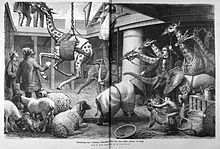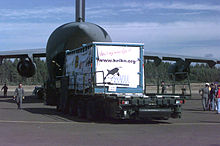
The Houston Zoo is a 55-acre (22 ha) zoological park located within Hermann Park in Houston, Texas, United States. The zoo houses over 6,000 animals from more than 900 species. It receives around 2 million visitors each year and is the second most visited zoo in the United States, surpassed only by the San Diego Zoo. It is accredited by the Association of Zoos and Aquariums (AZA).
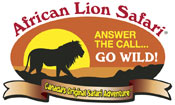
African Lion Safari is a family-owned safari park in Southern Ontario, Canada, straddling the cities of Hamilton and Cambridge, located 100 kilometres (62 mi) west of Toronto. Guests may tour seven game reserves, with a total area of about 740 acres, on tour buses or in visitors' own vehicles, where animals roam freely in contained areas. Accompanying the game reserves is a walking section where exotic birds and primates, as well as the park's herd of Asian elephants, are on display.

The Cheyenne Mountain Zoo is a zoological park located southwest of downtown Colorado Springs, Colorado, on Cheyenne Mountain in the United States. At an elevation of 6,714 feet (2,046 m) above sea level, it is the highest zoo in the country. The zoo covers 140 acres (57 ha), 40 of which are in use. The zoo houses more than 750 animals, representing nearly 170 different species, with more than 30 endangered species. The zoo was ranked the #4 best zoo in North America in 2018 by USA Today. It is accredited by the Association of Zoos and Aquariums.

Beijing Zoo is a zoological park in Xizhimen, Xicheng District, Beijing. Founded in 1906 during the late Qing dynasty, it is the oldest zoo in China and oldest public park in northern China. The zoo is also a center of zoological research that studies and breeds rare animals from various continents.

The Ueno Zoo is a 14.3-hectare (35-acre) zoo, managed by the Tokyo Metropolitan Government, and located in Taitō, Tokyo, Japan. It is Japan's oldest zoo, opened on March 20, 1882. It is served by Ueno Station, Keisei Ueno Station and Nezu Station, with convenient access from several public transportation networks. The Ueno Zoo Monorail, the first monorail in the country, connected the eastern and western parts of the grounds, however the line was suspended from 2019 onwards due to ageing infrastructure until being announced as closing permanently on 27th December 2023.

Copenhagen Zoo is a zoological garden in Copenhagen, Denmark. Founded in 1859, it is one of the oldest zoos in Europe and is a member of EAZA. It comprises 11 hectares and is located in the municipality of Frederiksberg, sandwiched between the parks of Frederiksberg Gardens and Søndermarken. With 1,571,331 visitors in 2019 it is the most visited zoo and one of the most visited attractions in Denmark. The zoo is noted for its new Elephant House designed by British architect Sir Norman Foster. The zoo maintains and promotes a number of European breeding programmes.
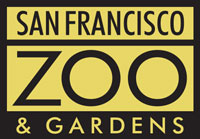
The San Francisco Zoo is a 100-acre (40 ha) zoo located in the southwestern corner of San Francisco, California, between Lake Merced and the Pacific Ocean along the Great Highway. The SF Zoo is a public institution, managed by the non-profit San Francisco Zoological Society, a 501(c)(3) organization. As of 2016, the zoo housed more than one thousand individual animals, representing more than 250 species. It is noted as the birthplace of Koko the gorilla, and, from 1974 to 2016, the home of Elly, the oldest black rhinoceros in North America.

Blackpool Zoo is a 32-acre (13 ha) zoo, owned by Parques Reunidos and located in the sea-side resort of Blackpool, Lancashire, England. It provides a home to over 1,350 animals from all over the world.
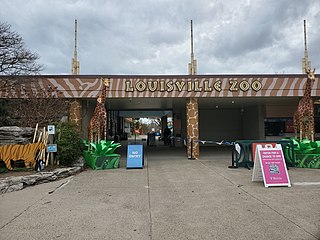
The Louisville Zoological Gardens, commonly known as the Louisville Zoo, is a 134-acre (54 ha) zoo in Louisville, Kentucky, situated in the city's Poplar Level neighborhood. Founded in 1969, the "State Zoo of Kentucky" currently exhibits over 1,200 animals in naturalistic and mixed animal settings representing both geographical areas and Biomes or habitats.

The Birmingham Zoo is a zoological park that opened in 1955 in Birmingham, Alabama, United States.
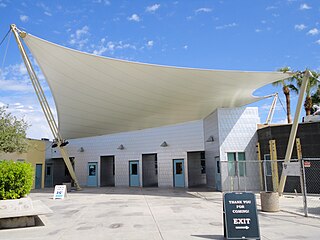
The Reid Park Zoo, founded in 1967, is a 24-acre (9.7 ha) city-owned and -operated nonprofit zoo located within Reid Park in Tucson, Arizona. The zoo features more than 500 animals. It was unofficially established in 1965 by Gene Reid, the parks and recreation director at the time. The zoo boasts approximately 500,00 visitors each year. It is accredited and certified with the Association of Zoos & Aquariums.

Bioparco di Roma is a 17-hectare (42-acre) zoological garden located on part of the original Villa Borghese estate in Rome, Italy. There are 1,114 animals of 222 species maintained.
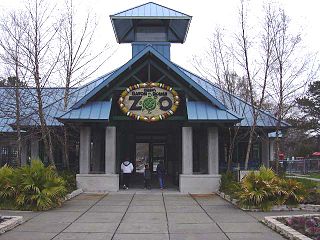
The Baton Rouge Zoo is located 15 minutes north of downtown Baton Rouge, Louisiana, United States. The zoo is owned and operated by the Recreation and Park Commission of East Baton Rouge Parish, Louisiana (BREC), and is home to over 800 animals from around the world. The zoo was first accredited by the Association of Zoos and Aquariums (AZA) in 1977 — the first zoo in Louisiana to be accredited. However, the zoo lost its accreditation in March 2018 due to infrastructure issues and animal escapes.

Barcelona Zoo is a zoo in the Parc de la Ciutadella in Barcelona, Catalonia, Spain. The zoo used to be internationally known as the home of Snowflake, the only known albino gorilla, who died in 2003.

Dresden Zoo, or Zoo Dresden, is a zoo in the city of Dresden, Germany. It was opened in 1861, making it Germany's fourth oldest zoo. It was originally designed by Peter Joseph Lenné.

The Nyíregyházi Zoo is a 30-hectare zoo located 5km north of Nyíregyháza, Hungary. The zoo is in the Sóstó recreation area, which includes a beach, spa, public swimming pool, open-air museum, and a forested oak tree park and accommodations for staying visitors.

The Wrocław Zoological Garden, known simply as the Wrocław Zoo, is a zoo on Wróblewski Street in Wrocław, Poland. It is the oldest zoo in Poland, having been first launched in 1865 as the Breslau Zoological Garden while the city was part of Prussia. During the World Wars it was first shut down, then reopened and finally destroyed. After World War II, it was rebuilt and ultimately opened in 1948 and now it is also the largest zoo in the country. The zoo covers 33 hectares near downtown Wrocław. It is home to about 10,500 animals representing about 1,132 species. In terms of the number of animal species it is the third largest zoological garden in the world.

The Virginia Zoological Park, commonly known as the Virginia Zoo, is a 53-acre (21 ha) zoo located adjacent to Lafayette Park in Norfolk, Virginia, United States. The zoo opened in 1900, and was accredited by the Association of Zoos and Aquariums (AZA) in 1987.
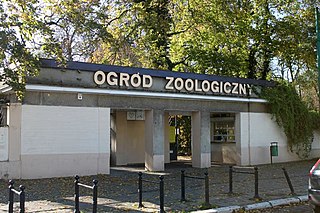
The Poznań Old Zoo is one of the oldest zoological gardens in Poland, located in the city of Poznań, Greater Poland Voivodeship. It was founded in 1874 and was included on the register of objects of cultural heritage in 1978 as a unique example of a vivarium. The zoo started as a few animals kept by a restaurant owner in the early 1870s. It can thus be considered the oldest continuously operating Polish zoological garden. Together with the New Zoo in Poznań, which opened in 1974, it forms an integral part of the whole complex known as The Zoological Garden in Poznań.

Zoo Osnabrück is located in south Osnabrück at the hillside of Schölerberg in Osnabrück, Germany. It was founded under the name "Heimattiergarten", and opened during the summer of 1936. Almost 3000 animals from roughly 300 species can be seen on the 23.5 ha (0.235 km2) land. It is famous for housing the Grolar Bear. This brought about many scientific inquiries into the zoo.



